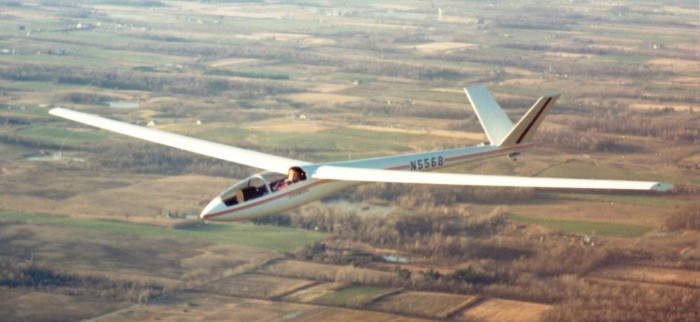Schreder / HP-18
Glider Reg. Number: N1YV
1976-84
Design & Development

The HP-18 is a Richard Schreder-designed metal Racing Class sailplane that was offered as a kit for homebuilding during the 1970s and 1980s.
The HP-18 is a flapped (15-meter) sailplane featuring a V-tail and 90-degree flaps for glidepath control. The fuselage is composed of a prefabricated composite forward fuselage and a semi-monocoque aft fuselage, and features steeply reclined seating and a side-stick controller although modifications using a conventional stick have been made.
As most homebuilts, the HP-18 has been constructed with many variations in detail. Perhaps the most significant version is the Super HP-18 developed by Canadians Ed Hollestelle and Udo Rumpf, which features a modified wing airfoil, winglets, a front-hinged canopy, conventional control stick and higher ballast capacity.
Major features:
- Very low cockpit with reclining seating position
- Sidestick (changed to conventional stick by some homebuilders)
- Two-piece canopy (changed to single piece forward opening by some homebuilders)
- V-tail that folds upwards for easy storage
- Wing structure composed of spars with caps pre-machined from solid aluminum plate and aluminum wing skins bonded to closely spaced foam ribs
- Fiberglass fuselage pod, wing tip skids and tail fairings
- Aluminum tail cone
- Winglets added by some homebuilders
- Water ballast carried inside the hollow aluminum wing spars
- Typical Schreder trailing edge flaps/airbrakes partially interconnected with the aileron
Specifications
General characteristics
- Crew: One pilot
- Length: 23 ft 2.4 in (7.07 m)
- Wingspan: 49 ft 2 in (15.00 m)
- Wing area: 113 ft2 (10.5 m2)
- Aspect ratio: 21.4
- Empty weight: 470 lb (213 kg)
- Gross weight: 970 lb (446 kg)
Performance
- Maximum speed: 150 mph (240 km/h)
- Maximum glide ratio: 38
- Rate of sink: 126 ft/min (0.6 m/s)